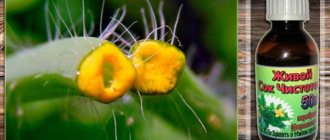Description and photo of calendula
The annual plant calendula from the Asteraceae family can be found almost all over the globe, especially in the temperate climate of the middle zone. Calendula grows in well-lit places with good moisture, has a straight stem and branched at the top. The plant usually reaches half a meter in height, but can grow a little higher.
The easiest way to recognize calendula is by its flowers - bright yellow or reddish-orange, shaped like chamomile flowers. Usually the flowers are collected in small baskets-inflorescences. The plant blooms throughout the summer - from June to September, and the achenes ripen in October.
Chemical composition of calendula flowers (marigolds)
The flowers of the plant, which are also known as marigolds, have great medicinal value. This is explained by the composition, which includes:
- resin and bitterness;
- saponins and flavonoids;
- phytoncides and essential oil;
- ascorbic acid;
- carotenoids;
- polysaccharides;
- salicylic acid;
- tannins;
- polyphenols and alkaloids;
- fixed oils;
- derivatives of oleanolic acid - triterpene glycosides;
- triterpenoids.
Chemical composition and healing properties
Calendula decoction contains a huge variety of biologically active substances. In particular, it includes:
- traces of essential oil that can cause the death of harmful microorganisms or suppress their development;
- coumarins, which have an anti-inflammatory effect;
- flavonoids, eliminating spasms and inflammatory processes, activating the production of bile and urine, preventing the appearance of tumors, stimulating the process of removing excess cholesterol, toxins and other harmful substances from the body;
- carotenoids, responsible for the synthesis of vitamin A in the body;
- sterols that help remove excess cholesterol from the body;
- triterpenoids (for example, oleanoic acid glycosides), which have an anti-inflammatory effect, accelerate the healing process of ulcers, and normalize the functioning of the nervous system;
- zinc, which strengthens the immune system of the human body;
- copper, which blocks the spread of inflammatory processes;
- selenium, which can strengthen the immune system, prevent the formation of atypical cells, and eliminate cardiac disorders.
In addition, the drug contains calcium, potassium, molybdenum, iron and magnesium.
What are the benefits of calendula?
Due to its rich composition, the plant has a positive effect on many systems and internal organs of the body. The benefits of calendula for the body are that the plant:
- is a good diuretic and choleretic agent;
- helps with colds - calendula is often used for coughs as a phlegm thinner;
- relieves inflammation and helps well with stomatitis, sore throat, periodontal disease and pharyngitis;
- has a beneficial effect on the stomach and intestines - calendula is very useful for gastritis and ulcers;
- stops bleeding and heals skin damage;
- increases immune resistance and improves body tone;
- helps in the fight against dermatitis and skin ailments;
- has a brightening effect on the skin when applied externally and removes age spots and freckles;
- strengthens the vascular system and heart.
With regular use, the plant can even serve as a cancer prevention - the substances contained in the composition promote healthy cell renewal. Calendula is useful for vision - decoctions and infusions protect the eyes from the development of myopia and astigmatism, quickly eliminate inflammation, and reduce the harm from constant work at the computer.
Calendula for women
The benefits of calendula for women's health are expressed in the fact that products based on the plant stop uterine bleeding and fight inflammation due to candidiasis. The beneficial properties of calendula in gynecology are manifested in the regulation of hormonal levels, the plant has a good effect on the nervous system, and is very useful to use during menopause.
Calendula for men
For representatives of the stronger sex, the plant is valuable because it strengthens blood vessels and protects against early heart attacks and strokes. Calendula is highly valued for potency; its beneficial properties are often used by men who are beginning to go bald. The medicinal plant strengthens hair and is responsible for its accelerated growth.
The healing properties of calendula
In medicine, calendula is used for many diseases, for example:
- for the treatment of ulcers, burns, boils, wounds, bruises, frostbite, warts, acne;
- cardiovascular diseases, which are accompanied by increased heart rate (tachycardia), shortness of breath and swelling;
- arterial hypertension (hypertension);
- gastritis, colitis, enterocolitis;
- peptic ulcer of the stomach and duodenum;
- inflammatory diseases of the liver and biliary tract;
- tonsillitis, tonsillitis, gingivitis, pharyngitis and inflammatory diseases of the upper respiratory tract;
- stomatitis, periodontal disease;
- stress, neurosis, insomnia;
- cervical erosion;
- trichomonas colpitis;
- thrush (candidiasis);
- during menopause.
In addition, calendula has the following properties:
- anti-inflammatory;
- wound healing;
- bactericidal;
- antispasmodic;
- blood purifying;
- bile and diuretic;
- soothing;
- reduces reflex excitability;
- accelerates tissue regeneration processes;
- increases the secretory function of the liver and stomach;
- helps improve the composition of bile.
Is it possible to take calendula during pregnancy and breastfeeding?
The benefits of calendula for a woman’s body during the period of bearing a child are manifested in the fact that the plant helps get rid of toxicosis and vomiting, and relieves inflammation in the oral cavity. Marigold flowers strengthen the immune system of the expectant mother and saturate the body with vitamins.
However, the health benefits of marigolds for pregnant women only appear when applied externally. Decoctions and infusions with increased strength cannot be used - they can harm the fetus.
It is better not to use the plant during lactation. Its components in mother's milk can be harmful for the baby, and will also affect the taste of the milk, and it is possible that problems with feeding will arise.
Contraindications to the use of calendula decoction
Unfortunately, the healing decoction of calendula also has a number of contraindications. In particular, the drug should not be used by pregnant women and persons suffering from the following pathologies:
- low blood pressure;
- bradycardia;
- allergies to substances present in the drug.
Particular caution when using calendula decoction is recommended for patients with urticaria and bronchial asthma. If there are any doubts regarding the safety of its use for medicinal purposes, it is necessary to obtain appropriate advice from a herbalist.
Is it possible for children to have calendula?
As an external remedy, the plant is highly recommended for children from the first days, as it softens the baby’s skin and helps prevent diaper rash and irritation.
But internal use of the plant is contraindicated for children under 12 years of age, as this may cause harm. For sore throat and inflammation of the oral cavity, it is permissible to give an older child calendula for the throat in the form of gargles, but you must carefully ensure that the baby does not swallow the product.
Attention! Since the properties of the plant can be harmful to the child, you should consult your pediatrician before use.
Traditional medicine recipes with calendula
The health benefits and harms of calendula are most clearly manifested in folk medicine. There are many effective plant-based recipes that help with a variety of ailments.
Calendula decoction
The benefits of calendula decoction orally are manifested in the treatment of gastritis and ulcers, colds and for preventive purposes. Preparing the decoction is very simple. Necessary:
- take 2 large spoons of dried flowers;
- pour 2 glasses of clean water;
- Boil over low heat for half an hour, and then allow the product to cool and strain it.
You can gargle with calendula several times a day, wipe wounds and burns with the decoction for disinfection. For internal use, drink a healthy decoction three times a day, only half a glass per dose.
Infusion of calendula flowers
It’s even easier to prepare a medicinal infusion based on the plant. To obtain it, you need to pour a glass of boiling water into 1 teaspoon of flowers, close the lid and wait until the product has completely cooled naturally. After this, the infusion is filtered and taken twice or thrice a day, 1 large spoon.
The benefits of calendula infusion are noticeable for cold symptoms. The product relieves inflammation in sore throats and has an expectorant effect on coughs. Also, the medicinal properties of calendula flowers are used as a natural sedative. The plant effectively relieves stress and helps regulate sleep.
Alcohol tincture of calendula
An alcoholic tincture based on the plant can bring considerable benefits. It is often used to lower blood pressure and treat colds; calendula tincture effectively helps against acne and when treating cuts.
Prepare the product as follows:
- flowers are tightly packed into a small glass vessel;
- the raw materials are filled to the top with vodka or alcohol so that the flowers are properly saturated;
- The vessel is closed with a stopper and put in a dark place for 2 weeks, not forgetting to shake the vessel periodically.
When the product is infused, the tincture is filtered and used as necessary for medical purposes. The benefits of calendula tincture are highly valued by hypertensive patients; they are recommended to take 20 drops of the product per glass of water three times a day. Calendula tincture for rinsing is first diluted in warm water - 1 teaspoon per 500 ml of liquid, so as not to burn the mucous membranes or harm the throat.
Important! The health benefits of marigolds as part of an alcoholic tincture will appear only with minimal dosages. If the product is abused, it will cause great harm.
Calendula ointment
A useful medicine is an ointment based on marigold flowers. You can not only buy it, but also prepare it at home yourself.
- To obtain an external preparation, pour half a glass of flowers with a glass of melted lard or 4 large spoons of Vaseline.
- Then the mixture is heated by steam for a quarter of an hour.
- Then cool and filter the thick mixture.
Homemade ointment helps well against infant diaper rash and dermatitis; its beneficial properties are noticeably manifested in varicose veins. Calendula treatment is recommended three times a day.
Calendula oil
Another useful remedy that you can prepare at home is marigold oil.
- To obtain it, fill a glass jar 3/4 full with dried flowers and fill them with high-quality olive oil.
- Close the jar with a lid and put it in a dark, cool place for 10 days.
- After the flowers are infused in the oil, the product is filtered and applied externally at least three times a day.
Marigold oil helps well in treating all kinds of skin damage - burns, abrasions and cuts, bruises, swelling and bruises. Calendula is used in the form of oil for heels; it promotes the healing of cracks.
Calendula tea
An effective remedy with cold and anti-inflammatory properties is tea based on a medicinal plant. They make it quickly: pour 1 large spoon of flowers with a couple of glasses of boiling water, brew for 10 minutes, strain and drink like ordinary tea.
The benefits and harms of calendula tea depend on the dosage. It is recommended to drink it no more than twice a day, and no longer than a week in a row.
Instructions for using calendula flowers - recipes for preparing tincture, decoction, ointment, oil
The following dosage forms can be prepared at home:
- Calendula flower infusion for gargling
To prepare it, take a spoonful of dried calendula inflorescences, place it in a container, add 250 ml of boiling water, and steam for 1 hour. This infusion can be used topically, gargle for colds, stomatitis or sore throat, or take a spoonful 3 times a day.
- Calendula tincture with alcohol - application
To prepare calendula tincture, take 10 grams of dry or fresh marigold flowers, add 100 ml of alcohol or high-quality vodka, let it sit for 24 hours. After this, you can use the tincture by first stirring it in a glass of water, at the rate of 1 spoon of tincture per 200 ml. It is very good to use as a local remedy in the treatment of burns, purulent wounds, and pyoderma.
If you apply calendula tincture to acne on the face, chest, and shoulders twice a day for at least a couple of weeks, you will notice a noticeable improvement in the condition of the skin.
Vodka tincture of marigolds is also used for hypertension (30-40 drops three times a day for a long time, at least a month). In addition to normalizing blood pressure, you can expect improved sleep, a reduction in the frequency of headaches, and increased performance.
If you drink calendula alcohol tincture 30 drops 4 times a day, gradually increasing the dose to one and a half teaspoons, the remedy will help with developed jaundice.
- Water infusion of marigolds
Pharmaceutical preparations based on calendula
The beneficial properties of the plant have been recognized not only in folk medicine, but also in official medicine. In pharmacies you can find many products for internal and external use, which contain marigolds. But the most popular are several preparations containing plant flowers.
- Cream and ointment called "Calendula". The pharmacological agent is intended for the treatment of wounds, scratches, skin irritations and burns. Calendula is effective against hemorrhoids; ointment and cream are used in the treatment of frostbite.
- "Calendula-P" - this drug is produced in the form of tablets; it is recommended for use for inflammation due to its antiseptic properties.
- “Caleflon” - tablets made from the flowers of the plant help in the treatment of gastritis, ulcers, liver and biliary tract diseases.
It is necessary to take pharmaceutical products strictly according to the instructions. However, they are available without a prescription, which means that they are practically incapable of causing harm to the body.
The use of calendula in home cosmetology
The beneficial properties of marigolds are used to maintain the beauty of skin and hair. Homemade masks, rinses and wash lotions are made from flowers.
Calendula for face
The benefit of calendula for the face is its cleansing and moisturizing effect. In addition, the plant tightens the skin and removes wrinkles. This mask is popular:
- 2 teaspoons of dry medicinal raw materials are mixed with the same amount of honey;
- pour a glass of clean water and stir thoroughly;
- leave for half an hour and apply to prepared skin.
When used weekly, the mask noticeably softens the face and restores elasticity to the skin. Calendula also helps with acne on the face.
Calendula for hair and scalp
Marigolds are used very widely for hair care; rinses and masks are prepared from the flowers; calendula is added to regular shampoos. The plant nourishes the hair roots and gives shine to the curls, makes them softer and more manageable, eliminates fragility and helps fight dandruff and dry skin.
The following recipes are most often used at home:
- if the scalp is too dry, the hair is treated with healthy oil from the flowers of the plant, it is rubbed into the roots of the hair twice a week 40 minutes before washing the hair;
- if you have dandruff, it is useful to treat your hair and scalp with a mixture of medicinal plant oil, burdock oil and egg yolk; the product will effectively moisturize the epidermis and help get rid of flaking;
- For weakened hair, use a rinse made from a decoction of a medicinal plant with the addition of onion juice; with regular use, the hair becomes strong and shiny.
Calendula for eyelashes, eyelids and eyebrows
The benefit of calendula for hair is that marigolds can add volume to eyelashes and eyebrow hairs and tone the sensitive skin of the eyelids. For example, you can use this tool:
- Mix 10 g of dried flowers with 1 teaspoon of castor oil;
- dilute the product with 100 ml of water;
- mix and spread over eyebrows and eyelashes for a quarter of an hour; you can use an old but clean mascara brush.
After just a couple of weeks, the effect will become noticeable - eyelashes and eyebrows will stop falling out and will become thicker and shinier.
It is useful to treat the eyelids with a frozen decoction; the product is poured into special molds and put in the freezer, and then used as needed. The properties of the medicinal plant tone the skin, relieve swelling and dark circles under the eyes.
Calendula for nails
The beneficial properties of the plant strengthen the nail plates and effectively soften the skin around them.
- To prevent your nails from crumbling or peeling, it is enough to make finger baths from the decoction every 3 days.
- You can also treat your nails with an ointment made from flowers and Vaseline - spread it over the nails, and then wrap your hands in cling film for half an hour or put on latex gloves.
Collection, preparation and storage of calendula
In decoctions, infusions and teas based on calendula, mainly the flowering part of the plant is used. The collection of marigolds is carried out during the period of active flowering - from June to September, in clear weather in the morning. Fully blossomed flowers are best suited for harvesting raw materials, and it is desirable that they be large and without visible damage.
Dry the plant naturally, spreading the raw materials on a flat surface in a shaded place with good access to fresh air. After the flowers are completely dry, they are placed in paper or fabric bags and stored in the dark and cool. Dry flowers retain their beneficial properties for up to 2 years.
Collection rules
Under natural conditions, the plant blooms with the arrival of the warm season, and flowering lasts until late autumn. That is why you can collect inflorescences several times a season. In addition, after each such collection of baskets, the plant blooms even more intensely, and the number of inflorescences only increases.
The baskets must be collected together with the peduncle. The buds have the greatest pharmacological value during the first 2 days after blooming. Once you have collected the plant material, it should be dried and dried in a ventilated area, away from direct sunlight.
Dried calendula flowers can retain their healing properties for several years, but if storage conditions are met: in a dark place, in a glass container.
How and when to collect calendula for culinary and medicinal purposes, how and how long to store so that it does not lose its beneficial properties?
Calendula flowers can be collected from July to August in dry, sunny weather. This should be done on young plants immediately after they begin to flower (bloom) - it is important not to miss the right time, otherwise you risk wasting time. Calendula flowers collected at the wrong time may lose their color or crumble during drying, which makes them unsuitable for use.
Marigold inflorescences are cut off with sharp scissors at the base of the stem and laid out to dry in a warm, well-ventilated place, one at a time or in special dryers at a temperature of 50-60°C. Dried flowers are carefully collected and stored in a cool place in paper or cloth bags without any admixture of any other plants. Remember that the slightest access to moisture is guaranteed to spoil the raw materials.
Dried calendula retains its beneficial properties for no more than one and a half years, so we do not recommend making huge reserves - next year you will reap a new orange “harvest”.
- Medicinal herbs - when to collect and how to dry correctly
Calendar for the preparation of medicinal herbs and their shelf life.









